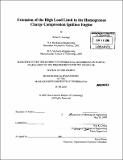Extension of the high load limit in the Homogeneous Charge Compression Ignition engine
Author(s)
Scaringe, Robert J. (Robert Joseph)
DownloadFull printable version (67.29Mb)
Other Contributors
Massachusetts Institute of Technology. Dept. of Mechanical Engineering.
Advisor
Wai K. Cheng.
Terms of use
Metadata
Show full item recordAbstract
The Homogeneous Charge Compression Ignition (HCCI) engine offers diesel-like efficiency with very low soot and NOx emissions. In a HCCI engine, a premixed charge of air, fuel and burned gas is compressed to achieve autoigntion. Combustion occurs throughout the chamber volume resulting in short overall burn duration. This short burn duration can cause excessively high pressure rise rates which lead to unacceptable engine noise and potentially reduced engine life. To combat this high pressure rise rate the engine must be operating with significant diluent, either excess air or burned exhaust gas. However this high level of dilution limits the specific output of the HCCI engine to levels far below spark ignition or diesel engines. The high load limit is a major challenge for the HCCI engine. This study utilized a single cylinder research to examine the high load limit and possible methods to extend it. The details of the high load limit were first explored across a range of intake temperatures, boost pressures, trapped residual fractions, equivalence ratios and external EGR ratios for a gasoline fueled HCCI engine. A significant finding was that the high load limit always occurs at the misfire limit and that for a given pressure rise rate constraint, the high load limit occurs at lowest possible intake pressure and trapped residual fraction needed to prevent misfire. A possible means to allow operation at higher boost pressures is to utilize cooled external EGR or to reduce the intake temperature. For a given burn fraction, increasing the EGR rate or reducing the intake temperature provided reduced MPRR. (cont.) However with these changes, the misfire limit also shifted such that the value of the maximum load does not materially change. Thus boosting coupled with EGR or intake temperature reduction can not be used to significantly extend the high load limit. A correlation was developed for the burn duration. Multi-zone combustion simulations were used to confirm the form of this correlation. The multi-zone based correlations were then used to quantitatively examine the potential of thermal stratification as a means to extend the high load limit. It was shown that for a doubling of the width of the in-cylinder temperature distribution, a 30% increase in the high load limit is possible.
Description
Thesis (Ph. D.)--Massachusetts Institute of Technology, Dept. of Mechanical Engineering, 2009. Includes bibliographical references (p. 120-121).
Date issued
2009Department
Massachusetts Institute of Technology. Department of Mechanical EngineeringPublisher
Massachusetts Institute of Technology
Keywords
Mechanical Engineering.